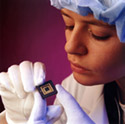
Networks funded from 1989-2003
Canadian Institute for Telecommunications Research - CITR
www.citr.ece.mcgill.ca
 Earth orbit will soon become the next frontier for high speed
Internet communications, as Canadian researchers take a leading role in
developing satellite systems that could revolutionize the way users gain
access to the network. Rather than plugging their computers into a
ground-based network of wires and fiber-optic cables, logging on might
become a matter of turning to the sky for a signal as satellite television
viewers now do. Earth orbit will soon become the next frontier for high speed
Internet communications, as Canadian researchers take a leading role in
developing satellite systems that could revolutionize the way users gain
access to the network. Rather than plugging their computers into a
ground-based network of wires and fiber-optic cables, logging on might
become a matter of turning to the sky for a signal as satellite television
viewers now do.
A Canadian Institute for Telecommunications Research (CITR) team at
McGill University has been working on techniques for helping satellite and
earth-based communications systems interact more efficiently, so that
space-based networks could handle the speed and volume of data necessary
to relay complex multimedia information in real time.
 EMS Technologies Canada-one of the network's
founding industrial sponsors-is benefiting from CITR's research that has
important inputs for the firm's specific applications. Those applications
will be part of the commercial rollout of a European satellite network
that is due to begin service later this year. Société Européenne des
Satellites (SES), the continent's largest supplier of satellite
television, intends to pioneer the use of satellites for providing mass
market, high-speed Internet access. EMS Technologies Canada-one of the network's
founding industrial sponsors-is benefiting from CITR's research that has
important inputs for the firm's specific applications. Those applications
will be part of the commercial rollout of a European satellite network
that is due to begin service later this year. Société Européenne des
Satellites (SES), the continent's largest supplier of satellite
television, intends to pioneer the use of satellites for providing mass
market, high-speed Internet access.
EMS has contributed to the design of the SES end-to-end system,
including terminals to be employed by users of the new system, as well as
the electronic gateways that will link satellites with Internet Service
Providers. CITR has played a key role in supporting the development of the
communications MAC layer protocol, which is crucial to enabling these
various systems to communicate with one another.
 The company is continuing to take advantage
of CITR researchers' progress in refining these systems, which should
eventually make their way onto Canadian satellites such as the Telesat
Anik F2, due to be launched in early 2003. EMS will provide an
experimental on-board processor to demonstrate direct communications
between several small terminals that could be used simultaneously for
videoconferencing. The company is continuing to take advantage
of CITR researchers' progress in refining these systems, which should
eventually make their way onto Canadian satellites such as the Telesat
Anik F2, due to be launched in early 2003. EMS will provide an
experimental on-board processor to demonstrate direct communications
between several small terminals that could be used simultaneously for
videoconferencing.
CITR has cultivated a strong partnership with EMS over the past decade,
in part by training upwards of a dozen students who have since gone on to
work for the company. This steady flow of talent and expertise into the
Canadian research community has also been one of the network's leading
priorities.
CITR is devoted to increasing the flow of people and ideas to the
Canadian telecommunications R&D community by sponsoring industrially
relevant research.

| Scientific Director: |
David V. Plant
Professor
McGill
University |
| Network Manager: |
Nicolas A. Ignatieff |
| Chair, Board of Directors: |
Peter J.M. Nicholson
Chief Strategy Officer
BCE
Mobile Communications Inc.
Montreal, Quebec |
| No. of Participating
Institutions: |
- 18 universities
- 20 industries
- 4 government
departments/agencies |
| Administrative Centre: |
McGill University |
| Total Award for fiscal years 1998-1999
to 2001-2003: $7,700,000 |
| Provincial Reach: |

Click on image for bigger
view |
| ![]()